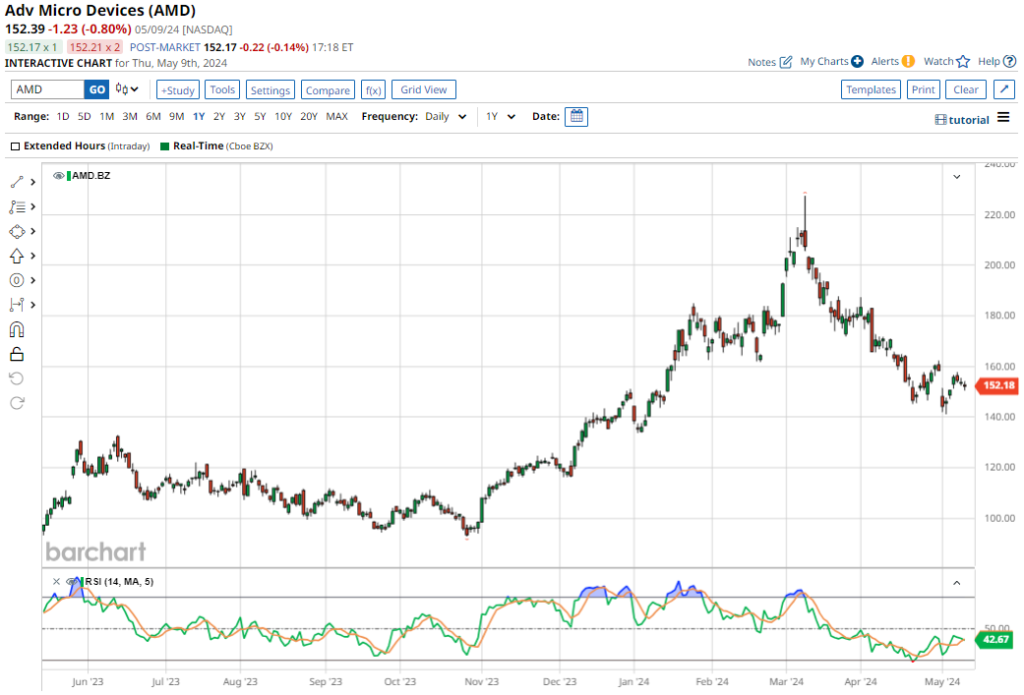The Resilience of Advanced Micro Devices
Semiconductors stand as the unsung heroes of our modern world, fueling our technological advancements from sleek smartphones to sophisticated cars. Among the key players in this arena is Advanced Micro Devices, Inc. (AMD), a notable name renowned for its groundbreaking semiconductor innovations, particularly in microprocessors and graphics chips. Despite a remarkable surge driven by AI integration, the year 2024 marked a sudden downturn for AMD, with its shares falling by a staggering 32.96% from their peak earlier this year.
A Glimpse Into Advanced Micro Devices Stock
Established in 1969, the Santa Clara-based AMD has cemented its presence in the semiconductor realm, catering to various markets such as data centers, embedded systems, gaming, and PCs. The company has garnered a reputation for spearheading advancements in modern computing, boasting a market capitalization of $248.3 billion. In recent years, AMD has emerged as a major contender in the semiconductor industry, making significant strides in both central processing units (CPUs) and graphics processing units (GPUs) markets, with its Ryzen processors and Radeon graphics cards gaining substantial traction.
Notably, Advanced Micro Devices’ stock has witnessed a commendable 60.3% increase over the past year, outperforming benchmarks like the S&P 500 Index’s 26.6% returns and the S&P Semiconductor SPDR’s (XSD) 31.4% gains. Trading at a modest 9.71 times forward earnings ratio, AMD presents itself as an affordable investment option when compared to industry peers like Broadcom (AVGO) and Marvell Technology Inc (MRVL).
Analyzing AMD’s Q1 Performance
Following the release of its Q1 earnings report on April 30, AMD encountered a downturn in its stock value. While the company’s revenue of $5.5 billion aligned with Wall Street predictions, displaying a modest 2.2% annual growth, its adjusted earnings per share (EPS) rose by 3.3% year-over-year to $0.62, narrowly surpassing analysts’ projections.
The data center segment recorded an 80% revenue surge, reaching $2.3 billion, primarily attributed to the success of the MI300 series. Additionally, the client segment witnessed an 85% revenue spike, with Ryzen AI chips at the forefront. Despite temporary declines in gaming and embedded segments, a rebound is anticipated later this year. Notably, sales of the MI300 accelerator surpassed $1 billion since Q4 2023, with AMD processors fueling cloud operations for tech giants like Google, Amazon, and Oracle.
Looking ahead, AMD’s Executive Vice President, CFO, and Treasurer Jean Hu expressed optimism about seizing large AI opportunities in the future, foreseeing continued revenue growth and margin enhancements. The company’s Q2 forecast anticipates a revenue of $5.7 billion (with a variance of plus or minus $300 million), indicating a 4% sequential and 6% annual increase. Furthermore, the projection for AI chip sales reaching $4 billion in 2024 surpasses the earlier forecast of $3.5 billion issued in January.
Analysts tracking Advanced Micro Devices predict an EPS growth to $2.62 in fiscal 2024, marking a 31.7% annual increase, followed by a substantial 67.9% surge to $4.40 in fiscal 2025.
Projected Trajectory for AMD Stock
Post-earnings, multiple brokerage firms, including UBS and Bank of America, slightly revised their price targets for AMD. However, the overall sentiment remains bullish, with a consensus “Strong Buy” rating for AMD. Out of 34 analysts covering the stock, 28 advocate a “Strong Buy,” one suggests a “Moderate Buy,” and the remaining five recommend a “Hold.”
The average analyst price target for Advanced Micro hovers at $192.37, hinting at a potential upside of 26.2%. Notably, the Street’s highest target price of $265 paints a picture of a possible 73.9% rally in the stock value.



